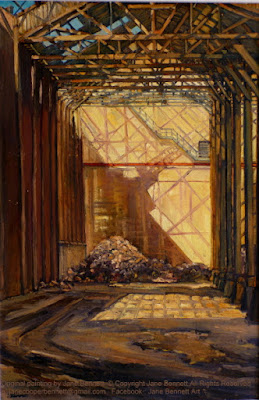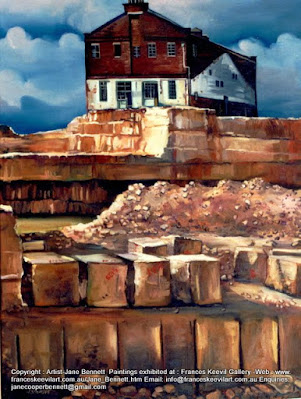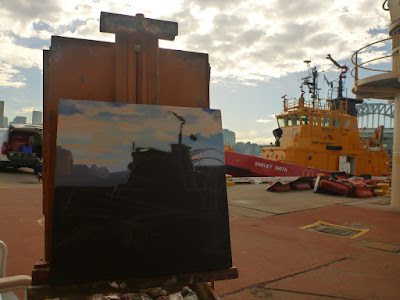My painting of a partly demolished Pyrmont warehouse is a finalist in the 2012 NSW Parliament Plein Air Painting Prize.
This Exhibition will be held:
Tue 1 May - Thu 31 May 2012
NSW Parliament, Macquarie Street Sydney 8.30 AM - 5.45 PM
'Industrial Cathedral, the Cooperage, C.S.R. Refinery'
oil on canvas 91 x 61cm
FINALIST : Plein Air Painting Prize 2012
This canvas is of a sandstone escarpment seen through the screen of rotting timber beams that once were part of the Cooperage building in the CSR Refinery.
This painting focuses on the mysterious patterns of shadow made by the fall of light. The cavernous space and rows of columns reminded me of the interiors of cathedrals and ruined abbeys.
The wall at the back was the famous butter-yellow Pyrmont sandstone, which has been quarried to decorate the best loved historic Sydney buildings such as the Australian Museum, the Sydney GPO, the University of Sydney.
At sunset the sandstone rock face caught the last rays of light and the derelict warehouse was transformed.
This painting has come full circle. Out of Pyrmont into an Eastern suburbs gallery, back to Pyrmont as part of the 2011 Pyrmont Festival, then to Macquarie St as a finalist in the NSW Parliament Plein Air Painting Prize.
Oddly enough the sandstone wall shown at the back of the painting has made a similar journey as the painting. Some of it has made a triumphant visit to Macquarie Street's heritage showcase of 19th century architecture.
After being sliced and diced like a huge block of cheese by LendLease during the excavation for the McCaffrey's apartments in Jacksons Landing, it then suffered a few years in ignominious limbo, in a stockpiled pyramid under the no-man's land under the Anzac Bridge .
Ironically it came from the former "Paradise Quarry" so it should have been spared limbo.
Now these blocks are having a glorious afterlife being lovingly reshaped by master stonemasons in the Alexandria yards, to adorn the classic façades of Sydney's most beautiful buildings.
Some appropriate graffiti from one of the onsite port-a-loos during the re-opening of the quarry - "Sandstone Rocks!"
Totally.
U230 'Gargoyle, University of Sydney' 2009
oil on board 25 x 20cm
This alarming little creature is one of the refurbished gargoyles hanging off one of the spires of the University of Sydney. He was carved from the sandstone extracted from the Jacksons Landing excavations, possibly even from the escarpment I painted in the background of "Industrial Cathedral".
The MacLaurin Hall is an important piece of heritage of the University Quadrangle Building. Designed by the Government Architect of the day Walter Liberty Vernon it was constructed in 1911 as the Fisher Library ,which was later relocated in 1963.
In October 2007, the University began conservation work on the façade of MacLaurin Hall. This included work on the sandstone walls, bosses, windows and gargoyles. They were treated with a poultice to remove salt; the poultice was left on for 10 days or until it fell off, and then re-applied to ensure the salt was removed.
Before this treatment, some of the gargoyles had shown signs of splitting and falling. As the original gargoyles crumbled they therefore had to be replaced or extensively refurbished so that they wouldn't fall on people's heads from a great height.
Imagine one of those landing on your head!
Must be one of those Legendary "drop bears".














